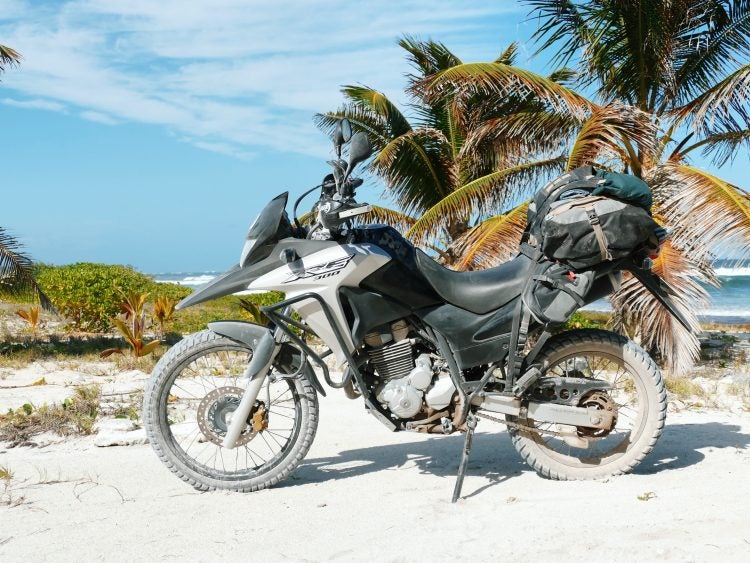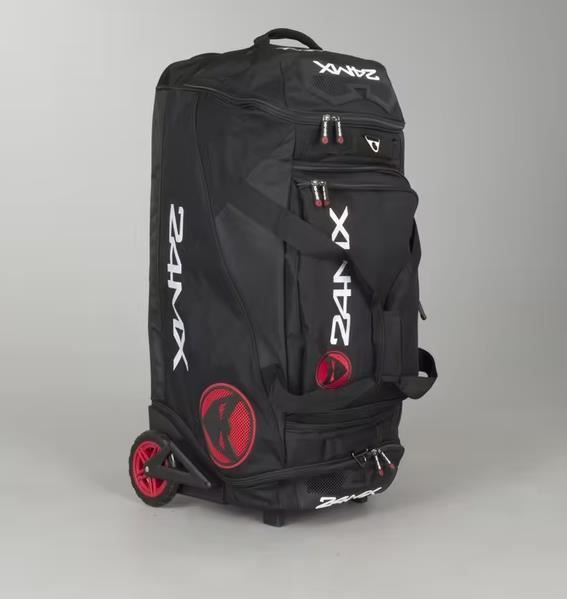Fly and Ride Gear Packing Tips // ADV Rider
6 min readCan’t take off to travel the world indefinitely? The next best thing, arguably, is “fly and ride” adventures: pick a destination, find a rental bike or an organized motorcycle tour, fly, ride, fly back. An awesome way to escape for a little – or even see the entire world one bite at a time.
But here’s the conundrum: most motorcycle rental and touring companies don’t offer gear locally. Even if they do, there’s the hassle of whether it fits and whether they’ve got the right sizes – or the right gear, period. That means you’ve got to bring your own. Simple? Sort of.
Carry-On Only
My first fly-and-ride adventure took place somewhere in Portugal a few years back, where I was lucky enough to be invited to a rally training event. Back then, I didn’t have any serious off-road gear, so I packed my essentials into a Mosko duffel (perfect size for a carry-on, by the way), put my Klim Artemis and my boots on, took my helmet with me, and that was that. No checked-in luggage, no extra fees, happy days.
And it was, at least flying to Portugal. Flying back presented a bit of a challenge: during Day Two of the rally training, we went through some farmers’ fields with free-roaming cattle and, having gravely miscalculated the depth of a puddle ahead of me, I’d splashed myself in mud from head to toe. Not just any mud, though. Remember the mention of cattle? Yeah.
There was no time to put the gear through a wash cycle as my flight departed three hours after the finish of the event; I’d hosed everything down best as I could, but my gear still looked…unsightly, at best. Worse still, it had a faint aroma of that farmers’ field. Needless to say, my fellow passengers weren’t impressed.
I’d flown in full gear many times since, mostly because I’m a) usually too cheap for checked luggage, especially if it’s an extra cost and b) these days, a little paranoid that the airline might lose my luggage. So far, so good, although I admit to studiously avoiding cow fields and making sure I have a chance to wash the gear before flying back out again.
The great thing about flying in gear with just a carry-on is that you don’t need to queue at check-in to drop off your bags, wait at luggage belts, or get stressed over multiple or complicated connections – you just get on and off the plane, light, free, and ready to go.

Mosko Moto duffel is perfect for lightweight lugagge – and a carry-on. Photo: Egle Gerulaityte
The drawbacks? It’s uncomfortable, especially on long-haul flights; schlepping from gate to gate in full gear can be an ordeal; the airport security is never amused, and people inquire why is it that you’re wearing snowboarding boots if you’re headed to Belize. Still: it’s an option, provided you’re traveling with ADV gear and if it’s mostly two- to four-hour flights with no self-transfer connections.
Gear Hauler Hacks
What if you’re going to ride technical dirt, however, and adventure gear isn’t cutting it? Theoretically, you could wear your armor, knee braces, and the rest on the plane. Realistically, it’d probably be a nightmare.
I recently found myself in a situation where I needed to bring both my adventure and my off-road gear; ridiculous, I know, but it had to be done. And I needed to draw a line somewhere. After years of flying with the ever-faithful Mosko duffel or cheap luggage bought last-minute, I finally committed to buying a thing of beauty I’d seen other riders travel with: a gear hauler.
Oh what glory awaited! My 150L MX 24 gear hauler has separate compartments for boots, helmet, and gear, a myriad of wonderful, zippered pockets and sections and things, and – gasp – wheels. For the first time, I wasn’t trudging around airports hauling the duffel on my back and sweating under a four-season jacket while trying to awkwardly balance the helmet stuffed with my passport and a cup of coffee with one hand. No: I was gracefully wheeling the MX24 around, flip-flopping through security, weightless and carefree, and wearing a shirt and a pair of jeans like a respectable citizen. Drop the gear hauler off, carry a small backpack with my laptop, camera, and toothbrush on board, collect the bag at the final destination, and Bob’s your uncle.

Photo: Egle Gerulaityte
It felt magnificent, but it came at a price (literally). While the MX24 gear hauler cost about a hundred euros and is as comfortable as promised, it’s a huge and lumpy bag, and some airlines ask to check it in under “oversized luggage”. Even if they don’t, the thing itself weighs almost 7 kilos (15 pounds), which means you’ve got to subtract that from your actual luggage weight; if you don’t, you’ll be paying extra, and that adds up over multiple flights. Then, you have the tight connection conundrum: if you’ve booked your flights with different airlines and need to check your bag out and check it back in at a connecting airport with barely 40 minutes to spare, it’s a close call. Finally, there’s always the worry of lost luggage; it doesn’t happen often, to be sure, but if it does and you need to buy gear locally or miss your tour, it’s a costly headache.
A gear hauler is comfy, but it’s probably cheaper to get a simple airport suitcase or roller bag that weighs much less and isn’t frowned upon by harassed check-in agents. You’ll still need to carry your helmet on board, but most airlines don’t have an issue with that, and let’s face it, it’s probably a safer option anyhow as the checked luggage gets tossed and dropped all over the place before it gets into the cargo hold.
Gear Smuggling System
Depending on your destination, shipping your gear back and forth might also be an option. I’ve done this within Europe a couple of times, forwarding my off-road armor, knee braces, and neck brace for a rally, then either shipping it to the next destination or having friends bring it somewhere. If you’re flying to ride from, say, the Netherlands to Portugal or New York to Colorado, that’s a feasible option (although, cost-wise, about the same as checked luggage). DHL’ing your gear to Ecuador or Thailand, on the other hand, is pretty much out of the question.
Finally, it’s possible to pool luggage if you’re traveling with friends or, if you tend to frequent your fly-and-ride destination several times a year, simply leave a set of gear at the bike rental place or with the tour operator.
All in all, a perfect solution for packing your gear probably doesn’t exist – as with anything else, you either spend more or sweat more. I’m still trying to find a good way to haul gear when I’m flying to ride, constantly trying (and, mostly, failing) to outsmart myself with either too much or too little luggage or, as is usually the case, attempting to throw things together last-minute and hope for the best. So far, the only rule of thumb that makes sense to me is sacrificing comfort for short flights (up to 4 hours) and spending a bit more on checked luggage and/or extra legroom for the long-haul, multiple connection flights (7 hours+), as well as trying to induce the least amount of annoyance to check-in agents, security staff, flight attendants, and fellow passengers.
What’s your rule of thumb when packing gear for fly-and-ride adventures? Share in the comments below!


